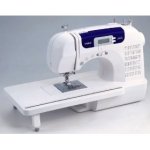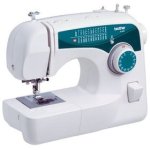How to Choose the Best Sewing Machine
2009
Type of Work
What are you buying the sewing machine for? This is the ultimate question that will help you mark the range of sewing machines you’ll be looking at.
1. Embroidery
There are single use embroidery machines that can only do embroidery; and there are dual use embroidery and sewing machines that can do sewing jobs besides embroidery.

To save money, I suggest that you buy a single use machine plus a separate electronic sewing machine if you do a whole lot of sewing jobs besides embroidery. This means your embroidery machine takes less wear and tear from usual sewing.
If you are doing mainly embroidery and only the occasional sewing of buttonholes and hems, get a dual use machine.
When buying an embroidery machine, whether single or dual use, you can look at these details:
- Size of the loop
- Number of built-in designs
- Size of designs and fonts
- Additional design cards or software for downloading designs
- USB port
- Easy selection and controls
2. Quilting
Most mid-end sewing machines can do quilts (you may have to get your own walking foot if it’s not included) but if you are doing a lot of quilts you can look for a good quilting sewing machine that provides plenty of quilting accessories and features.

I just bought a great quilting sewing machine – Brother CS6000I, just to do quilts, because it comes with a quilting table, walking foot, quilt guides and a wide selection of quilting stitches!
3. Basic sewing
Forget about embroidery and quilting machines, you’re just looking for a sewing machine that can make dresses, cushion covers, pillowcases, buttonholes, and fix that hem.

I suggest you get an electronic sewing machine. Personally I don’t think a computerized sewing machine is needed for basic sewing; a computer memory is only for designs.
- Price range – It’s easy to choose if you keep this in mind: there are only two main price ranges for electronic sewing machines – below $250 and above $250.
If you’re doing a lot of heavy fabrics (curtains, denims and multi-layers), definitely get the higher range.It’ll be worth it in the long run because expensive machines have a heavier and more durable make to last you a long time. The heavy fabrics feed better so the stitches will be finer too.
As far as I can see, you can still be pleasantly surprised by the quality of sewing machines below $250, but please don’t expect them to take heavy sewing for years and years.
Go ahead and buy these budget machines if you are only sewing fabrics of normal thickness most of the time. They will give you value for the price if you do plenty of dresses, covers, buttonholes and hems instead of heavy curtains and denims.
Singer 7442 is the best value electronic sewing machine while an even cheaper one for minimal sewing would be the Brother XL2600I.
- Type of fabric – What type of fabric will you be using?
Thick fabrics will need longer stitches. Check the machine for a good selection of stitches including long and short stitches for different thickness of fabrics.
The other feature to check is automatic tension. That will save you a lot of time because the machine adjusts the tension according to the fabric thickness without you having to do it manually.
Delicate fabrics like silk and chiffon are tricky to sew because they snag easily. If you’re using these fabrics check to see whether the presser foot can be adjusted to a lesser pressure. The right needles must be used (click here to see the different types of needles for different fabrics) but you can buy these to add if your machine does not include them.
Stretchy fabrics shall need a stretch stitch. If the machine you’re checking out does not say anything about the kinds of stitches it makes, read the reviews!
Large projects like bed sheets and curtains are easier done with an extension table. If your machine doesn’t come with one, check to see whether this can be added.
Person using it
Are you buying the sewing machine as a gift? There are some features that are convenient to certain people, while being cumbersome to others.
People with poor eyesight or shaky hands would find the auto threader very handy and time-saving. Some machines also have a thread cutter, but there are people who think it gets in the way.
Novices or young seamstresses would find a well-written manual helpful if they are not taking sewing classes. A more user-friendly sewing machine would also include auto tension, drop-in bobbin, and simple controls. I highly recommend the Singer 7470 Confidence for friendliness!
Portability
You might not be using your sewing machine at the same spot every time.
I myself like to place my sewing machine out in the open so that I can sew at every opportunity, and there is a cleared space for me to work and throw down all my stuff. But my girl friends have all kinds of habits like:
- Sewing on the dining table or shared spots and clearing away after use
- Using a different spot in the house every time
- Bringing the sewing machine to sewing classes
- Bringing the sewing machine to a friend’s house to sew
So when you buy a sewing machine, you’ll have to take this into consideration. If you’re not like me, you’ll need a lightweight machine to carry around or store away after use, but it shouldn’t be so light that it will prance on the table like an excited dog when you feed it with fabric.
Machines with some weight are good for heavy fabrics. In short, you’ll have to strike a balance between having a machine sturdy enough for fabrics you’re using, and light enough to carry. All the better if the machine comes with a hard cover carrying case.
Tip: If your machine does slide a bit when in use, place it on a sheet of thin rubber mat.
For more sewing machine reviews and recommendations, go to my Sewing Machine Review main page.
Related Posts:
- Sewing Machine Review – Main
- Brother XL2600I 25-stitch Free-arm Sewing Machine – Best Basic Sewing Machine
- Singer 7442 Electronic Sewing Machine – Best Value Electronic Sewing Machine
- Brother ES2000 77-stich – Best Budget Computerized Sewing Machine
- Brother CS6000I Computerized Free-arm Sewing Machine – Best Quilting Sewing Machine
- Singer 7470 Confidence Electronic Sewing Machine – Best User-Friendly Sewing Machine
Filed in Sewing Machine
Tags: Brother, button, buttons, cloth, cloths, design, fabric, fashion, hem, home, home craft, patchwork, quilt, quilting, quilts, review, reviews, seamstress, sew, sewing, Sewing Machine, sewing machines, sews, singer, stitch, stitches